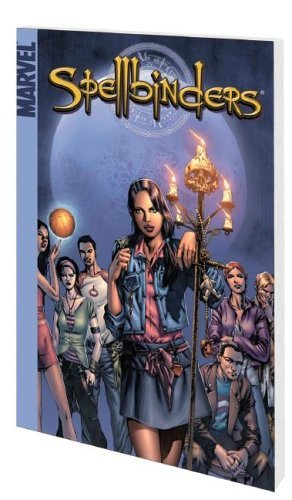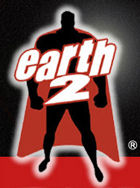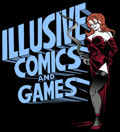| Spellbinders:
Signs & Wonders
I really
have to give credit to Mike Carey for what he does in comics;
the man flies under the radar writing very good books like
Lucifer and filling in expertly on previously established
series like Hellblazer and Ultimate Fantastic
Four. Carey has proven himself to be both an innovative
creator and a go-to-man when you want someone to maintain
a certain level of storytelling quality in a series that’s
already written well. He’s a great utility writer.
Which
makes me wonder what exactly happened in Spellbinders
to make it quite so dull and uninspired.
Admittedly,
the story elements of magic and death are things that Carey
is more than familiar with from his work on Lucifer
and other Vertigo titles. With her parents, Kim Vesco
moves from Chicago to Salem, MA, escaping some obscure type
of unpleasantness.
Upon
arriving in town, Kim comes to discover that Salem is more
than just a tourist attraction for those with a love of
the history of Puritanical executions; there are witches
in Salem, and they’re all in high school. The school
is divided among the “Wicks” and “Blanks”
or rather the magical and non-magical student body, and
while the students seem unfazed by the use of magic, when
certain spells and certain people start getting hurt in
magical attacks, high school suddenly becomes even more
dangerous than usual. Kim may be the key to ending these
attacks, but that’s only if she survives a few herself
and somehow makes sense of the powers rising around her.
The
problem with this story isn’t the characters, though
they have some issues, but rather that Carey has given us
a very generic plot structure. Step 1: enter new girl(boy).
Step 2: have something weird going on at school. Step 3:
have girl(boy) stop said weirdness, making friends along
the way.
It’s
not the most creative way to start or end a miniseries,
especially when you only have that certain amount of issues
in which to tell a rich story. Kim enters her new world
with very little trouble and quickly becomes not only immersed
in the ways of magic, but adept as well. She’s the
forced upon heroine of the tale, but everything she does
comes easily to her. While this is a trait that can be beneficial
to a character, the ability to walk through any situation
and come out the winner is one better fit for a character
that has been around longer and earned the reputation, like
Wolverine. When that happens, it’s more about watching
the character to see exactly how he or she wins this time.
Carey
has set it up early that his main character can do very
little or no wrong, and it just doesn’t fit the reality
of the fictional situation. Because the reader doesn’t
really believe that Kim will fail, when she wins it is just
not exciting and even the way in which she vanquishes her
opponent is unimpressive and obvious from at least 10 pages
previous.
Carey
is also juggling too large a cast for a miniseries, though
the mystical reasons for having seven characters rings true.
But too many characters almost always means too little characterization.
Other than the cookie-cutter personalities that show through
on the surface, the reader really only gets a glimpse at
Kim as a character. While Kim is likable, even what little
we find out about her is pretty generic; she’s an
artist of some sort and has a dark spot in her past, neither
of which is elaborated on since we never see any of her
work and only find out that she’s an orphan. The fact
that the script depends on this fact in order for her to
even be possessed of magical abilities is also treated with
almost no urgency.
The
worst part about the characters is that they are not in
any way dynamic. They are pushed around by the story instead
of being apart of it. It’s ham-fisted writing that
I really didn’t expect from Carey. He never really
fleshes out his world of magic either as the reader is never
really sure if magic is used outside the school or by the
parents of the children, though it is hinted that they do.
Not
helping is the artwork, which is perfectly serviceable artwork
that simply hits on a few little pet peeves of mine: one
being the drawing of characters that should be teenagers
barely out of preteenage years as if they were twenty-five
and all had memberships to NYSC. Mike Perkins’ artwork
isn’t gratuitous or overtly sexual like some significant
parts of our industry, and I thank him for that, but he
seems to have no grasp of teenage anatomy. Not everyone
will be tall, lanky, well muscled or attractive. Hormones
fly around the teenage body faster than Superman on crank
so some body variation happens.
I’m
not saying make your characters ugly, but make them different.
Outside of hair and clothes styles, there’s very little
that’s distinctive about his characters. He reminds
me of Butch Guice’s work from Ruse in that
respect. I work in high schools and see students every day
and not one of them has the same body as the next.
When
you build a character visually, it’s just as hard
as creating the written history of the character: the character’s
appearance should speak to what type of person, superhero,
or giant space monster that it happens to be. Also, Perkins’
style of drawing magic couldn’t be more boring, using
a glowing sigil around the hands to indicate every time
a spell is cast. It’s only noticeable thanks to the
coloring, and it also helps suck the energy out of the plot.
I expected
better of Carey, and having never read Perkins I expected
nothing, so I ended up being half disappointed. It’s
a passable story and since Marvel has lumped it under the
Marvel Age heading (which it honestly can fit under since
the violence is rather muted), it only costs $7.99. It’s
not worth a pick up to me, but it might be a good comic
to try and wean a manga user off the opiate of the east
and onto the American brand of literary addiction. Signs and Wonders (Spellbinders, Vol. 1)
|






